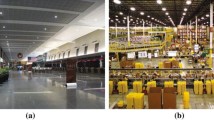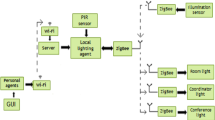Abstract
Tracking location is challenging due to the numerous constraints of practical systems including, but not limited to global cost, device volume and weight, scalability and accuracy; these constraints are typically more severe for systems that should be wearable and used indoors. We investigate the use of wearable solar cells to track changing light conditions (a concept that we named LuxTrace) as a source of user displacement and activity data. We evaluate constraints of this approach and present results from an experimental validation of displacement and activity estimation. The results indicate that a distance estimation accuracy of 21 cm (80% quantile) can be achieved. A simple method to combine LuxTrace with complementary absolute location estimation methods is also presented. We apply carpet-like distributed RFID tags to demonstrate online learning of new lighting environments.










Similar content being viewed by others
Notes
Personal communication of the authors with a large Swiss light installation company.
This assumes that direct light is partially transmitted or filtered by the window.
Manufacturer: RWE SCHOTT Solar, model: ASI 3 Oi 04/057/050.
Manufacturer: XSens Technologies B.V., model: MT9B.
References
Getting I (1993) The Global Positioning System. IEEE Spect 30(12):36–47
Bretz EA (2003) Precision navigation in European skies. IEEE Spect 40:16
European Commission: (2005) Galileo project webpage. http://www.europa.eu.int/comm/dgs/energy_transport/galileo/index_en.htm
European Commission: (2003) The Galilei Project: GALILEO design consolidation. http://europa.eu.int/comm/dgs/energy_transport/galileo/doc/
Ni LM, Liu Y, Lau YC, Patil AP (2004) LANDMARC: indoor location sensing using active RFID. Wirel Netw 10:701–710
Vossiek M, Wiebking L, Gulden P, Weighardt J, Hoffmann C (2003) Wireless local positioning—concepts, solutions, applications. In: Radio and wireless conference. RAWCON ’03.
Agiwal A, Khandpur P, Saran H (2004) LOCATOR: location estimation system For wireless LANs. In: WMASH ’04: Proceedings of the 2nd ACM international workshop on Wireless mobile applications and services on WLAN hotspots, ACM Press, New York, 102–109
Andy W, Alan J, Andy H (1997) A new location technique for the active office. IEEE Pers Comm 4:42–47
Vildjiounaite E, Malm E, Kaartinen J, Alahuhta P (2002) Location estimation indoors by means of small computing power devices, accelerometers, magnetic sensors, and map knowledge. In: Pervasive ’02: proceedings of the 1st international conference on pervasive computing, Springer, Berlin Heidelberg New York 211–224
Lee S, Mase K (2001) A personal indoor navigation system using wearable sensors. In: Proceedings of the 2nd international symposium of mixed reality (ISMR01), Yokohama
Randell C, Muller H (2001) Low cost indoor positioning system. In: Abowd GD Springer, Berlin Heidelberg New York 42–48
HeyWow Project: HeyWow project webpage (2005) http://www.heywow.com.
Bohn, J, Vogt H (2003) Robust probabilistic positioning based on high-level sensor-fusion and map knowledge. Technical Report 421, Institute for pervasive computing, Dept. of computer science, ETH Zurich
Angermann M, Kammann J, Robertson P, Steingass, A, Strang T (2001) Software representation for heterogeneous location data sources within a probabilistic framework. In: International symposium on location based services for cellular users (Locellus) 107–118
Kargl F, Bernauer A (2005) The COMPASS location system, LoCA, pp 105–112
Hightower J, Brumitt B, Borriello G (2002) The location stack: a layered model for location in ubiquitous computing. In: Proceedings of the 4th IEEE Workshop on Mobile Computing Systems & Applications (WMCSA 2002), Callicoon, IEEE Computer Society Press, New York, 22–28
Bohn, J (2006) Prototypical implementation of location-aware services based on super-distributed RFID tags. In: Proceedings of the 19th international conference on architecture of computing systems (ARCS’06), Frankfurt am Main, Germany. Number 3894 in LNCS, Springer, Berlin Heidelberg New York 69–83
Amft O, Lauffer M, Ossevoort S, Macaluso F, Lukowicz P, Tröster G (2004) Design of the QBIC wearable computing platform. In: Proceedings of the 15th IEEE international conference on application-specific systems, architectures and processors
Fox, D (1998) Markov localization: a probabilistic framework for mobile robot localization and navigation. PhD thesis, Institute of Computer Science, TU Dreseden
Talking Lights, Boston (2005) http://www.talking-lights.com/how.htm
Kavehrad M, Amirshahi, P (2005) Hybrid MV-LV Power lines and white light emitting diodes for triple-play broadband access communications. In: IEC comprehensive report on achieving the triple play: technologies and business models for success, ISBN: 978-1-931695-37-4. IEC, 167–178
Randall, J (2005) Designing indoor solar products. John, New York ISBN 0-470-01661-2
Cappozzo A (1981) Analysis of the linear displacement of the head and trunk during walking at different speeds. J Biomech 14:411–425
Amft O, Randall J, Tröster G (2005) Towards LuxTrace: using solar cells to support human position tracking. In: Proceedings of 2nd International Forum on Applied Wearable Computing, Zürich,
Bohn J, Mattern, F (2004) Super-distributed RFID tag infrastructures. In: Proceedings of the 2nd European Symposium on Ambient Intelligence (EUSAI 2004), Eindhoven, The Netherlands. Number 3295 in LNCS, Springer, Berlin Heidelberg New York 1–12
Hightower J, Borriello G (2001) A survey and taxonomy of location systems for ubiquitous computing. IEEE Comput 34:57–66
VHF-Technologies SA: Yverdon-les-Bains Switzerland. http://www.flexcell.ch (2005)
Author information
Authors and Affiliations
Corresponding author
Rights and permissions
About this article
Cite this article
Randall, J., Amft, O., Bohn, J. et al. LuxTrace: indoor positioning using building illumination. Pers Ubiquit Comput 11, 417–428 (2007). https://doi.org/10.1007/s00779-006-0097-0
Received:
Accepted:
Published:
Issue Date:
DOI: https://doi.org/10.1007/s00779-006-0097-0




